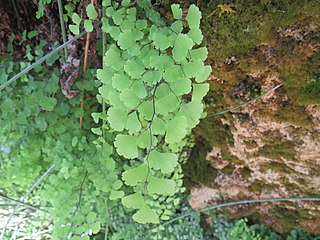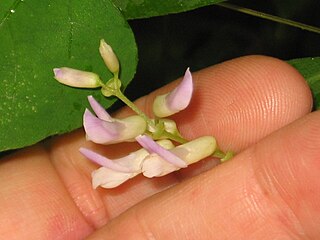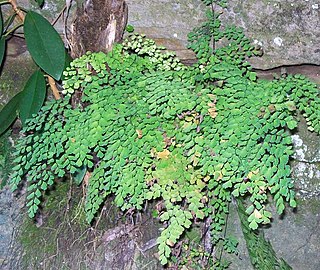
Adiantum, the maidenhair fern, is a genus of about 250 species of ferns in the subfamily Vittarioideae of the family Pteridaceae, though some researchers place it in its own family, Adiantaceae. The genus name comes from Greek, meaning "unwetted", referring to the fronds' ability to shed water without becoming wet.

Adiantum capillus-veneris, the Southern maidenhair fern, black maidenhair fern, maidenhair fern, and venus hair fern, is a species of ferns in the genus Adiantum and the family Pteridaceae with a subcosmopolitan worldwide distribution. It is cultivated as a popular garden fern and houseplant.

Adiantum diaphanum, the filmy maidenhair fern, is a species of fern in the genus Adiantum, native to East Asia and Australasia, from southern Japan south to New Zealand. It grows to 20 cm long at the most, with very dark green fronds covered with bristles.

Adiantum aleuticum, the western maidenhair fern or Aleutian maidenhair, is a species of deciduous fern in the genus Adiantum.

Adiantum lianxianense is a species of maidenhair fern native to China. While the IUCN Red List describes it as extinct, due to habitat loss, it may still survive, as it has frequently been confused with other members of the genus.

Franz Josef Ruprecht was an Austrian-born physician and botanist active in the Russian Empire, where he was known as Frants Ivanovič Ruprekht.

Adiantum jordanii is a perennial species of maidenhair fern, in the Vittarioideae subfamily of the Pteridaceae. The species is known by the common name California maidenhair.

Amphicarpaea, commonly known as hogpeanut, is a genus of flowering plants in the legume family, Fabaceae. It belongs to the subfamily Faboideae.

Adiantum hispidulum, commonly known as rough maidenhair fern or five-fingered jack, is a small fern in the family Pteridaceae of widespread distribution. It is found in Africa, Australia, Polynesia, Malesia, New Zealand and other Pacific Islands. Its fronds rise in clumps from rhizomes among rocks or in the soil in sheltered areas.

Adiantum aethiopicum, also known as the common maidenhair fern, is a small fern of widespread distribution, occurring in Africa, Australia, Norfolk Island and New Zealand.

Adiantum formosum, known as the giant maidenhair or black stem maidenhair is a fern found in Australia and New Zealand. It was one of the many species authored by Scottish botanist Robert Brown, appearing in his 1810 work Prodromus Florae Novae Hollandiae et Insulae Van Diemen. Its species name is the Latin adjective formosus "handsome" or "beautiful".

Adiantum viridimontanum, commonly known as Green Mountain maidenhair fern, is a rare fern found only in outcrops of serpentine rock in New England and Eastern Canada. The leaf blade is cut into finger-like segments, themselves once-divided, which are borne on the outer side of a curved, dark, glossy rachis. These finger-like segments are not individual leaves, but parts of a single compound leaf. The "fingers" may be drooping or erect, depending on whether the individual fern grows in shade or sunlight. Spores are borne under false indusia at the edge of the subdivisions of the leaf, a characteristic unique to the genus Adiantum.

Asplenium adiantum-nigrum is a common species of fern known by the common name black spleenwort. It is found mostly in Africa, Europe, and Eurasia, but is also native to a few locales in Mexico and the United States.

Adiantum silvaticum, is a small maidenhair fern found in eastern Australia. The habitat is open eucalyptus forest or rainforest. It may be seen on moist cliff faces and beside streams, often in high rainfall areas. Found as far south as Ulladulla in south-east New South Wales. This species prefers poorer soils. When with the hairless bluish form, it may be confused with Adiantum cunninghamii.

Asplenium onopteris, known as the Irish spleenwort or western black spleenwort is a species of fern found mostly throughout the Mediterranean Basin but also around the Eastern Atlantic.
Ren-Chang Ching, courtesy name Zinong, was a Chinese botanist who specialised in ferns.

Adiantum philippense,, also known as walking maidenhair fern, or black maidenhair, is a species of maidenhair fern (Adiantum) that is widely distributed through the southern hemisphere, notably Asia, Africa, and Madagascar.

Adiantum tenerum, common name brittle maidenhair fern, is a species of maidenhair fern belonging to the family Pteridaceae.
Adiantum myriosorum is a fern species very similar to Adiantum pedatum. It was once included in that species but now is recognized as being genetically distinct. It is native to Asia, from central China to northern India.
















